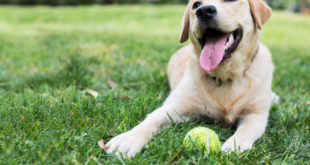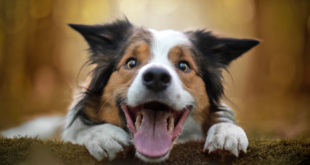You’re enjoying a leisurely walk with your furry companion when all of a sudden, you feel a sharp tug at the end of the leash. You look down to see your four-legged friend chomping down on the fabric, teeth gnashing and eyes wild with excitement. Sound familiar? If so, you’re not alone – many owners struggle with their dogs’ biting habits, whether it’s directed at their leash, their clothes, or even their skin. But fear not – with a little patience and some strategic training techniques, you can nip this bad habit in the bud and enjoy more peaceful walks with your pup. In this article, we’ll explore some of the common reasons for biting behavior, along with tips and tricks for taming the chomping monster and promoting more positive interactions between you and your dog. So grab your leash and let’s get started!
Table of Contents
1. Biting the Leash: Understanding Your Pup’s Behavior
One common problem that many dog owners face is their pup biting the leash during walks. This behavior can be frustrating, but it’s important to understand why your furry friend is doing it.
One reason a dog may bite the leash is because they are feeling anxious or stressed. If your pup is feeling overwhelmed by the sights, sounds, or smells around them, they may use the leash as a way to self-soothe. Providing your furry friend with plenty of positive reinforcement and a calm environment can help reduce their anxiety.
Another reason a dog may bite the leash is because they are trying to get your attention. Dogs are social creatures and love interacting with their human companions. If your pup is feeling ignored or neglected, they may resort to biting the leash in an attempt to get you to play or engage with them.
To help curb this behavior, it’s important to provide your pup with plenty of mental and physical stimulation. This can include going for longer walks, playing fetch, or engaging in interactive training sessions. Additionally, using a sturdy, chew-resistant leash and providing your dog with plenty of toys to chew on can help redirect their biting behavior in a positive way.
2. The Dangers of Leash Biting: Tips for Prevention
Leash biting in dogs is not only destructive behavior but also poses significant risks to their health and safety. Here are some tips for preventing this behavior and keeping your furry friend out of harm’s way.
– Provide Plenty of Exercise and Attention: Dogs that are bored or understimulated often turn to destructive behaviors like leash biting. Make sure your furry friend is getting enough exercise and mental stimulation throughout the day. Also, spend quality time playing and interacting with your dog to keep them entertained.
– Train Your Dog Early: Early training is critical to preventing leash biting. Start obedience training as soon as your dog is ready, and teach them how to walk calmly on a leash from the beginning. Consistency is key, so practice regularly and provide positive reinforcement for good behavior.
– Use a Suitable Leash: Using the right leash and collar can also help prevent leash biting. Choose a comfortable and secure collar that fits your dog well and a sturdy leash that cannot easily be chewed through.
Ultimately, the key to preventing leash biting is to understand your dog’s needs and behavior. If your dog persists in this behavior, consult with a veterinarian or professional dog trainer for additional guidance. By adopting the right techniques and providing sufficient training, your dog can develop into a well-behaved and happy companion.
3. Teaching Your Pup to Nip the Biting Habit in the Bud
One of the top concerns when bringing a new puppy home is the problem of biting. While it may seem cute and harmless at first, puppy biting can quickly become a bad habit that’s difficult to break. Fortunately, training your pup to nip this behavior in the bud is possible with a few simple tips.
First and foremost, give your pup plenty of opportunities to chew appropriate toys and bones. Puppies have a natural urge to chew, and redirecting this behavior can help prevent nipping. Be sure to provide a variety of chew toys, such as ropes and rubber balls, to keep your pup engaged and satisfied.
Secondly, teach your pup the “leave it” command. Using positive reinforcement techniques, encourage your pup to drop any item in their mouth when told to “leave it”. This can discourage grabbing and biting behavior and teach your pup that there are better things to do than bite and nip.
Finally, be sure to stay consistent with your training and be patient. Breaking a nipping habit takes time and effort, but with consistent training and positive reinforcement, you can nip it in the bud and enjoy a happy, well-behaved pup.
4. Replacing Leash Biting with Good Behavior: Positive Reinforcement Techniques
Leash biting is a common problem for many dog owners. This behavior can be frustrating and even dangerous, as it can lead to the leash breaking or the dog getting loose. Fortunately, there are positive reinforcement techniques that can help replace leash biting with good behavior.
One technique is to reward your dog for walking without biting the leash. You can give treats, verbal praise, or petting to reinforce the good behavior. It is important to reward your dog immediately after they exhibit the desired behavior to make the connection between the action and the reward.
Another technique is to redirect your dog’s attention when they start biting the leash. You can offer a toy or a chew instead and encourage them to play with it. This helps your dog understand that chewing on the leash is not acceptable behavior, but playing with a toy is.
It is important to note that punishment and aversive methods should not be used to correct leash biting. These techniques can create fear, anxiety, and aggression in dogs, which can lead to even more problematic behavior. Positive reinforcement techniques are a safer and more effective way to replace leash biting with good behavior.
5. Keeping the Leash Safe: Consistency and Patience in Training Your Pup
Training your pup to walk on a leash is not an easy task, but with consistency and patience, it can be done effectively. Here are some tips to ensure that your furry friend stays safe and comfortable while on their leash.
Firstly, make sure you are using the right kind of leash for your pup. A flat nylon or leather leash is recommended as it is strong and durable, but not too heavy or uncomfortable for your furry friend. It’s also important to regularly check the condition of the leash and replace it if it becomes worn or damaged.
When training your pup to walk on a leash, it’s important to remain consistent with your commands. Use the same phrases every time, such as “heel” or “let’s go” and reward your pup when they follow the command correctly. Start with short walks and gradually increase the distance over time. Don’t forget to praise and encourage them along the way.
Lastly, be patient with your pup. Training takes time and effort, but don’t give up. Stay positive and keep reinforcing good behavior. Remember, every pup is different and may take longer to adjust to walking on a leash than others. With the right tools and mindset, you and your furry friend can enjoy many safe and enjoyable walks together.
Having an adult dog who still bites can be a source of frustration, but there is hope! With patience and the tips in this article, you can work with your pup to effectively nip this uncontrollable habit. With the right training, soon you and your pup will be having fun together without any teeth sinking into flesh.
 Treat For Dog – Brain Training for Dogs, Dog Training & Obedience Discover Treat For Dog and get your pup on the path to smarter, happier, and healthier living with brain training for dogs.
Treat For Dog – Brain Training for Dogs, Dog Training & Obedience Discover Treat For Dog and get your pup on the path to smarter, happier, and healthier living with brain training for dogs.




